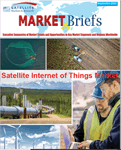Interview with Cynthia Harty, VP-Strategic Business Development, ST Engineering iDirect
Herndon, Va., September 1, 2021--Satellite Markets and Reserch spoke with Cynthia Harty, VP-Strategic Business Development, ST Engineering iDirect on their Satellite Internet of Things (IoT) solution. Cynthia’s expertise lies in operations and the introduction of new products, services and solutions to market, establishing channel and pricing strategy. As VP of Business Development, her focus is on the augmentation of the company’s 5-year plan and the partnerships that will enable the introduction of incremental capabilities to a product, solution or service and different go-to-market strategies.
Please give us a brief overview of the key features and benefits of your IoT solution?
 |
| Cynthia Harty |
We are offering flexible IoT Solutions utilizing our existing ST Engineering iDirect hub infrastructure that ease the entry of Service Providers into the IoT market. Our solutions utilizes a family of compact, lightweight IoT terminals that feature a tightly integrated satellite modem and flat-panel antenna design in Ka-band or Ku-band variants for fixed and mobile environments. For our Evolution and Velocity hub platforms, IoT waveform enabled universal linecards (ULC) provide simplified integration into an existing 5IF hub chassis as the IoT modulator and demodulator. Hidden carrier technology allows for IoT and VSAT carriers to coexist in the same bandwidth, ultimately optimizing use of allocated bandwidth. A Hub Base Station (HBS) element is available for activation on the Dialog platform. And what’s more, we are also providing optional service enablement solutions that offer Service Providers IoT-as-a-Service options to speed up market entry.
Explain a little bit more on the full turnkey solution that you offer?
We can provide customers with a complete connectivity solution that’s built on a flexible service enablement platform paired with IoT-as-a-service options for fixed and mobile IoT environments. These solutions ease the entry of Service Providers into the IoT market by reducing the upfront capital investments and operational complexity usually required to launch an IoT platform and service. Our IoT Solution provides a complete network management system (NMS) that supports both operational support system (OSS) functions as well as business support system (BSS) functions via an application program interfaces (API).
Your solution is specifically for GEO satellites, how does it compare to the non-GEO solutions now entering the market?
There are many narrowband service options available in L-Band, UHF and the newer smallsat constellations. Many of these services are limited in terms of use cases to Low Data Rate (LDR) applications only. They feature predefined payload sizes and pre-defined polling intervals ranging from per-minute to per-day, for example. Furthermore, they often don’t offer the flexibility in increasing throughput beyond the stated data rate and are not cost effective for higher data requirements, limiting use cases to Low Data Rate (LDR) applications only. We offer greater flexibility around branding and customized service plans, message size, polling intervals and bandwidth allocation depending on their end user application requirements in both voice and data use cases.
Our solution enables our partners to leverage their existing capacity, ST Engineering iDirect platforms and systems to launch an IoT service over Ku or Ka band, supporting both Low Data Rate (LDR) as well as Medium Data Rate (MDR) applications. Future development will support High Data Rate (HDR) applications as well.
What market segments will your IoT solution be serving?
Our solutions can support a myriad of use cases.
Transportation, which includes land, rail, and maritime, is by far the largest satellite IoT vertical due to satellite’s reach, reliability, and added security benefits. IoT provides a highly effective solution for asset tracking, fleet management, telematics and analysis of the mobile workforce.
In the Maritime sector, IoT finds use cases in tracking and management of small vessels. This is especially important for the small-scale fishing industry, which has IoT requirements around catch reporting for traceability and regulatory compliance.
In the Oil and Gas and Energy sector, use cases include pipeline monitoring, equipment telematics, predictive and preventative maintenance and beyond line-of-sight monitoring of pipelines and electricity distribution networks. This also applies to water networks, in terms of flow and pressure. IoT can also replace the need for on-site technicians for remote monitoring, advanced meter reading and asset tracking.
In Mining, IoT provides asset tracking of trucks, trailers and heavy equipment, site operations including safety and security. Construction is another sector that holds big potential for satellite IoT. It is used for asset tracking offering intelligence on engine hours, mileage report alerts, fuel consumption and location. On construction sites it gives important insight into operations, most notably safety and critical area monitoring as well as to track progress and security on site. Again, drone line of sight use applications enable easy inspection or survey.
As demand for sustainable farming practices increases, Agriculture, namely precision farming, is becoming increasingly popular. Satellite IoT has an integral role to play here to help analyze different aspects of the farm such as soil, harvest and crop management, fertilizer monitoring and greenhouse and open field management. Important environmental factors such as rainfall, temperature, wind speed, CO2, power production and consumption of solar panels can be closely watched. IoT can also be utilized for livestock tracking and asset tracking for farm machinery as well and drone beyond line of sight for inspection of crops.
Can you cite a specific example of how your IoT solution will be implemented in the market and what benefits does it provide to your client?
We are currently working with a number of our customers and partners helping them implement industrial IoT solutions across a range of vertical markets, including utilities, oil & gas, maritime, transportation and environmental monitoring. In one specific example, we had a customer that was suffering performance issues with their incumbent satellite IoT solution. Having limited control over their satellite resources, they suffered from congestion, high latency and data losses for a time critical monitoring application. This was further compounded with high connectivity costs. Using our IoT solution, they were able to re-purpose their investments in ST Engineering iDirect infrastructure and run the same application over their existing network and capacity. This has enabled them greater control over the end –to-end service, to offer higher reliability and scalability, all while maintaining an optimum cost of connectivity.
How do you see the IoT solution you are currently providing evolving, in other words, why should your potential clients invest in it
 |
| To read or download a pdf of a MarketBrief report on Satellite Internet of Things Market sponsored by ST Engineering iDirect click here. |
now?
As we move towards the implementation of Industry 4.0 and begin to realize the plethora of opportunities that advanced technologies such as 5G, edge computing, automation, orchestration and virtualization bring to the table, here is an opportunity to obtain a complete connectivity solution from a single, trusted source. As the industry leader across many market segments it’s our vision to constantly evolve our solutions to meet the current and future needs of our customers. It’s what has made us and our customers successful.
As part of this future vision, we are pioneering a world-class cloud-based satellite ground infrastructure platform that enables multi-orbit, multi-access technology services in a converged telco environment driven by the best business case and market strategy.
Our model for ground infrastructure is one that’s fully digitized and virtualized, is based on open standards, and orchestrates dynamically configured space resources with real-time demand on the ground. It advances key aspects of a satellite network from more powerful waveforms and more intelligent bandwidth allocation to more capable remotes. It transforms satellite service delivery so that it’s perfectly seamless, significantly more economical, infinitely scalable, and can deliver whatever data rate and functionality is needed for any possible application that satellite connectivity can support.
Related Articles:
MarketBrief Report on the Satellite Internet of Things Market





